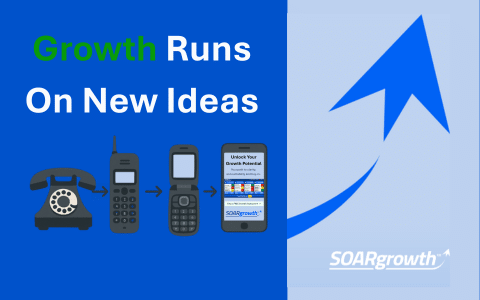By Larry Goddard, Laurence Franklin and Jennifer Goddard
Growth Beyond the Organic Path
Every business leader eventually reaches a point where the easier levers of organic growth—riding the wave of market growth, protecting the current customer base, expanding wallet share, winning back customers, securing new customers, and even launching new products—start to plateau. At that moment, the question becomes: how do you achieve the next level of scale, capability, or market reach without waiting years for internal efforts to mature?
That’s where Non-Organic Growth comes in. In the SOAR Growth Engine™, non-organic growth refers to strategies that expand a business through external relationships, investments, or combinations rather than purely internal initiatives. These include acquisitions, joint ventures, alliances, licensing, franchising, and strategic hires.
Among these, acquisitions are the boldest lever. They can instantly reshape a company’s trajectory—adding customers, capacity, expertise, or geography virtually overnight. But they also carry the highest stakes. When executed well, they can multiply enterprise value; when mismanaged, they can destroy it just as quickly.
Why Acquisitions Matter
Acquisitions accelerate growth in ways organic strategies cannot. They provide:
- Speed: Immediate access to new markets, customers, and capabilities.
- Scale: Expanded capacity and stronger market presence.
- Capabilities: Access to specialized expertise, technologies, and IP.
- Synergy: Cost reductions from shared infrastructure and overhead.
- Strategic Positioning: The ability to eliminate a competitor, strengthen supply chains, or achieve pricing power.
For many middle-market businesses, acquisitions compress time—they achieve in 12 months what might otherwise take five years.
The Major Types of Acquisitions
Acquisitions come in many forms, each serving a distinct strategic purpose and requiring different levels of investment, integration, and risk tolerance.
1. Competitor Acquisitions
Buying a direct competitor increases market share, reduces pricing pressure, and creates scale efficiencies.
Upside: stronger pricing power, customer consolidation, operational overlap.
Risks: culture clashes, redundant assets, customer churn from overlap.
2. Customer Acquisitions (Forward Integration)
Acquiring a distributor or downstream business improves control of the value chain and margins.
Example: a manufacturer acquiring its main distributor to strengthen channel control and profitability.
Risks: alienating other customers, stretching management, and increased working capital needs.
3. Supplier Acquisitions (Backward Integration)
Buying a supplier stabilizes cost, quality, and supply chain reliability.
Example: a packaging company purchasing a raw-material provider to lock in pricing and continuity.
Risks: capital intensity, unfamiliar operational complexity.
4. Adjacent Market Acquisitions
Diversify into related markets or applications.
Example: a plastics manufacturer in healthcare expanding into aerospace via an acquisition.
Upside: diversification, risk mitigation, and higher margin potential.
Challenges: certification requirements, customer qualification, differing standards.
5. Geographic Acquisitions
Expanding into new regions—domestic or international—without greenfield risk.
Example: a Midwest manufacturer buying a West Coast firm to serve national customers.
Considerations: logistics, local labor markets, regional regulations.
6. Capability or IP Acquisitions
Buying for know-how, technology, or innovation.
Example: acquiring an R&D firm to accelerate innovation or internalize a key patent.
Risks: talent retention and post-acquisition integration of processes.
The Ideal Acquisition Target
Before launching any acquisition search, companies must define what “ideal” looks like. Too many deals fail because the buyer lacked clarity about the target’s attributes—or about why the acquisition truly mattered.
A well-run acquisition program starts with a Target Profile—a clear list of characteristics that define what makes a company worth pursuing. These criteria depend on strategic goals, risk appetite, and the company’s internal strengths.
Common target profiles include:
- Turnarounds or Underperforming Businesses – Buyers with operational strength often seek undervalued or distressed businesses that can be acquired cheaply and improved through better sales execution, cost management, or leadership. These can yield high returns if integration succeeds.
- High-Quality, Well-Run Companies – Other acquirers prefer to pay a premium for excellence. They target profitable, well-managed companies with loyal customers, stable cash flow, and cultural alignment—reducing integration risk and accelerating ROI.
- Strategic Capability Targets – Businesses offering unique technologies, intellectual property, or specialized expertise that complement the buyer’s existing capabilities.
- Market Entry Targets – Companies that provide access to new industries, segments, or regions, giving the buyer an immediate foothold.
- Customer or Supplier Integration Targets – Companies that strengthen supply chain control or distribution efficiency.
Other possible criteria include:
- Size and scale relative to the acquirer
- Cultural compatibility and leadership depth
- Margin profile and customer concentration
- Brand reputation and customer loyalty
- Systems and process maturity
- Regulatory or environmental exposure
- Ease of integration and synergy potential
Finally, leaders should always ask: Why would this business be attractive to us?
Is it access to customers? Capabilities? Geography? Talent? Cost reduction? Competitive defense? Clarity on the “why” prevents chasing deals that look good on paper but don’t advance the strategic mission.
The Economics of Acquisitions
Every acquisition is both a financial and strategic decision. Understanding the economics behind it helps ensure disciplined execution.
Upfront Investments Include:
- Purchase Price: Often 3–8× EBITDA for mid-market firms—but can be significantly higher for businesses with strong growth potential, proprietary technology, or unique competitive advantages.
- Transaction Fees: Legal, accounting, advisory, due diligence, and financing costs can add 3–7% to the total transaction.
- Integration Costs: Systems, rebranding, relocation, redundancy, cultural alignment.
- Opportunity Cost: Time and management focus diverted from core operations.
Returns on Investment Come From:
- Incremental revenue growth through new customers, geographies, or products.
- Cost synergies from overlapping functions, shared services, and improved purchasing power.
- Margin improvements from pricing leverage or supply chain control.
- Valuation lift as scale and diversification improve the risk profile.
Typical Payback Period: 3–7 years, depending on the speed of integration and realization of synergies.
Financing Options:
- Cash Purchase: Simple and clean but consumes liquidity.
- Debt Financing: Maintains ownership but increases leverage risk.
- Equity or Minority Investors: Dilutes ownership but may bring strategic partners.
- Earn-Outs and Seller Financing: Useful when bridging valuation gaps or aligning future performance incentives.
Financial discipline is critical. A good deal done at the wrong price—or with poor financing—can erode all the intended benefits.
The Due Diligence Imperative
Due diligence protects the buyer from hidden surprises. It should go far beyond the balance sheet.
- Strategic Fit: Does this deal strengthen one or more of the SOAR Growth Engine™ pillars?
- Financial: Quality of earnings, working capital health, contingent or undisclosed liabilities, tax exposure.
- Operational: Supply chain reliability, customer concentration, technology, and process maturity.
- Cultural: Leadership compatibility, culture & values, communication style, decision-making pace.
- Legal & Regulatory: Contracts, environmental liabilities, labor law compliance, IP protection.
The Acquisition Process: Step-by-Step
- Define the Strategic Intent: Clarify what the acquisition must accomplish.
- Identify Target Profiles: Build a target list using clear attributes and screening criteria.
- Deal Sourcing: Use industry networks, associations, bankers, accountants, lawyers and direct outreach.
- Initial Contact & NDA: Establish confidentiality and access for preliminary discussions.
- Valuation & Indicative Offer: Use EBITDA multiples, DCF models, and synergy valuation to create a price range.
- Letter of Intent (LOI): Define deal structure, exclusivity, and due diligence timelines.
- Due Diligence: Verify all financial, legal, and operational assumptions.
- Negotiation & Purchase Agreement: Balance risk with clear representations, warranties, and indemnities.
- Closing & Financing: Finalize terms, secure funding, and coordinate with counsel.
- Post-Deal Integration: Begin before closing—align leadership, systems, and messaging.
Making Acquisitions Work
The real challenge starts after the deal closes.
- Integration Planning: Launch a 100-day plan before signing.
- Cultural Alignment: Decide whether to blend teams or run separately.
- Communicate: Clear description of strategy, growth plans, expectations, progress and challenges.
- Synergy Realization: Quantify and track cross-selling, cost savings, and efficiency gains.
- Retention Strategies: Secure key employees and customer relationships immediately.
- Measurement: Create dashboards with KPIs—EBITDA lift, revenue retention, synergy achievement, turnover, and satisfaction.
Common Pitfalls
- Overpaying: Letting “deal fever” override valuation logic.
- Underestimating Integration: Failing to account for cultural or system friction.
- Neglecting Customers: Losing focus on service quality during transition.
- Taking Team Members for Granted: people can make or break the deal.
- Over-Leveraging: Straining cash flow or capital flexibility.
- Chasing Strategy Drift: Buying companies that distract from core strengths.
Conclusion
Acquisitions remain one of the boldest levers in the SOAR Growth Engine™. They demand clarity of purpose, rigorous financial discipline, and relentless follow-through. For mid-market businesses, a single well-planned acquisition can expand scale, diversify revenue, and build lasting strategic advantage.
But the most successful acquirers know: buying growth is not the same as earning it. The deal is just the beginning. The real value comes from integration, culture, communications and leadership.
The next article in this series will explore other non-organic growth pathways—strategic hires, alliances, joint ventures, licensing, and franchising—that deliver scale and capability without full ownership risk.
©Copyright, 2025, The Parkland Group, Inc. All Rights Reserved.



